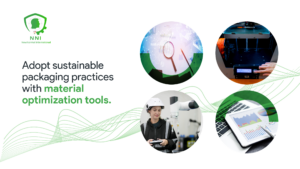Embracing Environmental Accountability in Business Operations
In an era where environmental responsibility is paramount, the initiative to improve sustainability with carbon footprint tracking per product has become a critical agenda for businesses. Carbon footprint tracking enables companies to measure the environmental impact of their products, from production to disposal. This article delves into the significance of carbon footprint tracking and how it can lead businesses towards more sustainable and eco-friendly practices.
The Importance of Carbon Footprint Tracking in Sustainability
Carbon footprint tracking transcends mere tallying of emissions; it serves as a strategic imperative for orchestrating unwavering transparency, building a future-ready enterprise, and empowering businesses to navigate the ever-evolving landscape of environmental responsibility with unparalleled precision. This transformative approach empowers organizations to:
1. Achieve Unprecedented Environmental Fluency and Untangle the Web of Hidden Impacts: By delving deeper than surface-level calculations, businesses can leverage sophisticated life cycle assessments, granular data analytics, and cutting-edge supply chain mapping tools to decode the hidden language of environmental impacts. This grants unprecedented environmental fluency, revealing the true carbon footprint of products across their entire life cycle, from raw material extraction to end-of-life disposal.
2. Proactively Mitigate Climate Risks and Outmaneuver Environmental Disruptions: Equipped with hyper-precise environmental intelligence, businesses can abandon the rigid dance of reactive damage control and embrace the proactive waltz of risk mitigation. By identifying key areas for emission reduction, optimizing supply chains, and implementing innovative green technologies, businesses can outmaneuver environmental disruptions, build resilience against climate risks, and become stewards of a sustainable future.
3. Forge Deeper Stakeholder Connections and Fuel Unwavering Transparency: Unveiling the true carbon footprint of products fosters unwavering transparency, building trust with consumers, investors, and regulators alike. Businesses can leverage this transparency to forge deeper stakeholder connections, fuel authentic brand purpose, and establish themselves as pioneers in the realm of environmental responsibility.
4. Identify and Seize Untapped Green Opportunities before Competitors Catch On: By pinpointing hidden emission hotspots and exploring alternative materials and processes, businesses can unearth hidden gems of green opportunity before rivals even glimpse them. This empowers dominating emerging green markets, establishing first-mover advantage in sustainable solutions, and carving out a unique space in the world of environmentally conscious consumer choices.
5. Foster a Culture of Data-Driven Sustainability and Shatter Silos of Information: Hyper-precise environmental intelligence acts as a democratizing force, shattering information silos and empowering collaborative sustainability initiatives across all levels of the organization. This fosters a culture of data-driven sustainability, ensuring every decision is fueled by the freshest insights and guided by unwavering environmental responsibility.
6. Secure a Competitive Advantage and Lead the Charge Towards a Greener Future: By prioritizing unwavering transparency, proactively mitigating risks, forging deeper stakeholder connections, seizing green opportunities, fostering data-driven sustainability, and shattering information silos, organizations gain a significant competitive advantage. This empowers them to lead the charge towards a greener future, outpace rivals who cling to outdated practices, and cement their position as the undisputed leaders in the realm of environmental responsibility.
7. Build a Future-Ready Enterprise and Embrace Unwavering Adaptability: Investing in robust environmental intelligence platforms and cultivating a culture of continuous learning future-proofs businesses by equipping them with the necessary tools and mindset to thrive in a world where environmental responsibility is no longer a choice, but an imperative. This ensures long-term viability, safeguards against the pitfalls of unsustainable practices, and empowers organizations to continuously evolve their environmental intelligence frameworks for enduring success.
Beyond Carbon Footprints: A Foundation for Unwavering Transparency and Enduring Growth:
By embracing the transformative power of hyper-precise environmental intelligence and adopting a data-driven approach to navigating the intricate world of environmental responsibility, organizations unlock the true potential for achieving unwavering transparency, a future-ready enterprise, and enduring growth. This empowers them to untangle the web of hidden impacts, outmaneuver environmental disruptions, forge deeper stakeholder connections, seize green opportunities, embrace data-driven sustainability, secure a competitive advantage, and build a future-ready enterprise, ultimately building a future where their environmental intelligence hums with real-time data, their agility surpasses every ecological challenge, and their growth is a testament to the unparalleled power of orchestrating unwavering transparency in the ever-evolving dance of environmental responsibility.
Embrace the transformative power of hyper-precise environmental intelligence and embark on a journey towards a future where your environmental fluency outshines the competition, your agility outmaneuvers every disruption, and your growth is fueled by the unparalleled power of understanding the ever-changing language of environmental impact and dancing to its dynamic rhythm with unwavering transparency and confidence.
Change Management for Implementing Carbon Tracking Systems
Integrating carbon footprint tracking into business operations requires a comprehensive change management strategy. This process involves adopting new technologies for tracking emissions, re-evaluating supply chains, and possibly redesigning products. Effective change management ensures that the transition to sustainable practices is smoothly implemented and embraced by all stakeholders.
Executive Coaching for Sustainable Leadership
Leadership plays a vital role in driving sustainability initiatives like carbon footprint tracking. Executive coaching can empower leaders with the skills to navigate the challenges of implementing sustainable practices, inspire teams to embrace eco-friendly methods, and communicate the company’s sustainability goals effectively. Coaching focuses on developing leadership skills in sustainability, strategic planning, and environmental stewardship.
Effective Communication in Sustainability Initiatives
Effective communication is essential in successfully implementing carbon footprint tracking. It involves clearly conveying the purpose and benefits of sustainability initiatives to employees, customers, and stakeholders. Open communication helps build a culture of environmental responsibility within the organization and enhances the company’s reputation as a sustainable business.
Leveraging Technology for Enhanced Carbon Tracking
Advanced technology, particularly in Generative Artificial Intelligence (AI), can significantly improve the accuracy and efficiency of carbon footprint tracking. AI-driven tools can analyze large data sets, assess the environmental impact of production processes, and offer insights for reducing emissions. By leveraging AI technology, businesses can gain a more comprehensive understanding of their carbon footprint and identify effective strategies for sustainability.
Conclusion Carbon Footprint Tracking
In conclusion, improving sustainability with carbon footprint tracking per product is a vital step for businesses committed to environmental responsibility. This practice not only contributes to reducing global carbon emissions but also positions companies as leaders in sustainable business practices. By prioritizing carbon footprint tracking, businesses can make a significant impact on the environment and drive positive change in their industry.
#Sustainability, #CarbonFootprint, #EcoFriendlyBusiness, #EnvironmentalResponsibility, #GreenInnovation


















